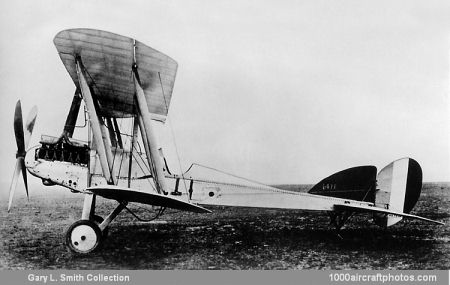Production B.E.12s embodied several detail modifications to provide increased fuel capacity and improved performance. Normal armament applied to the B.E.12 consisted of a single Vickers gun mounted to port on the fuselage and equipped with Vickers interrupter gear. Occasionally, additional fire-power was provided by a Lewis gun installed to starboard on a Strange mounting and alternative armament fitted consisted of a pair of fuselage Lewis guns on Strange mountings.
The B.E.12 arrived in France to do battle in mid-summer of 1916 but, in producing the conversion, the fundamental fact had been overlooked that inherent stability was a highly-developed feature of the B.E.2c but was not a quality which was in the least compatible with a fighter's primary and essential requirement of maneuverability. The extra power and armament did nothing to meet this need and the B.E.12 was patently unable to rise to the requirements for which, in good faith, it had been designed. After but a few months' use as a fighter, the B.E.12 was relegated to duties as a single-seat bomber.
And yet, a further attempt was made to turn the B.E.12 into a successful fighter by producing a new version with single-bay wings. This was the B.E.12a which had the same 150 hp RAF 4a engine but was fitted with greatly extended tips to the upper wings. These tips terminated in ailerons given exaggerated horn balances which reached forward to the leading edge. The design proved unsatisfactory and was modified to use normal B.E.2e wings with strut-connected ailerons on each tip. At first this revised type was known as the B.E.12Ae but soon reverted in nomenclature to B.E.12a.
All of this endeavor was in vain as the B.E.12a was as much a failure as the B.E.12 and served only in small numbers. The pictured aircraft was the first of a batch of 200 B.E.12 (s/n 6478 to 6677) produced by the Daimler Co. Ltd. of Radford, Coventry, and served with No. 76 Home Defence Squadron of the RFC.
Daimler was one of the most important contractors of WW I. The Daimler Motor Co. was established in 1896 at Motor Mills, Sandy Lane, Coventry, it was saved from financial difficulties when it was acquired by Birmingham Small Arms Co. in 1909. A new factory, known as the Radford Works, was opened in 1912, from where George Bulman, who was later famous as Hawker's Chief Test Pilot, undertook test-flying for Daimler.
The types built by Daimler were the Royal Aircraft Factory B.E.2c (200), B.E.12 (250) B.E.12a (50) B.E.12b (200), R.E.8 (1,450), and Airco D.H.10 (about forty-eight aircraft were built from an order for 150). Some 150 of the Daimler-built B.E.12 were completed as B.E.12b, with 200 hp Hispano-Suiza engines being fitted at the Northern Aircraft Repair Depot at Coal Aston, near Sheffield. Daimler received the largest single order of WW I for 850 R.E.8, and its war production totaled 2,198 aircraft.
